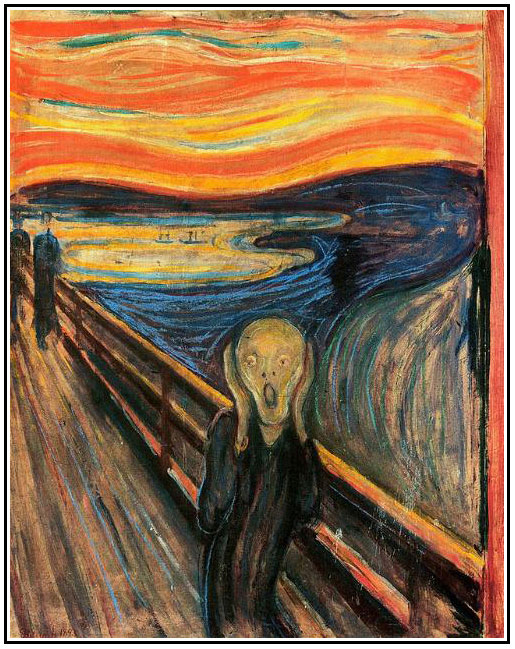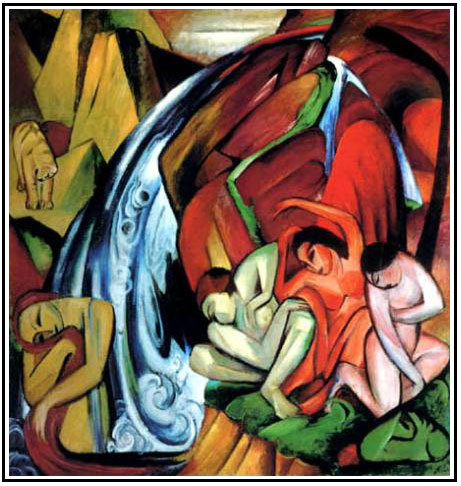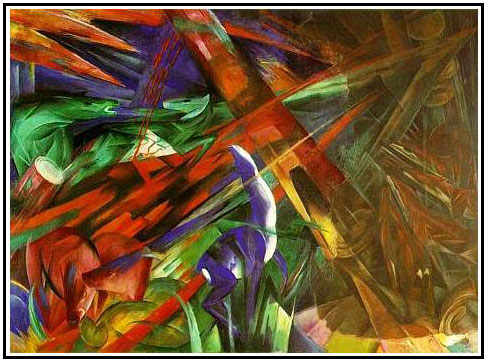EXPRESSIONISM (1905-1925)
Expressionism is notoriously difficult to define, in part because it "overlapped with
other major 'isms' of the modernist period: with Futurism, Cubism, Surrealism and Dada”. Expressionism
attempts to present the world from a subjective perspective, sometimes distorting it radically to evoke strong
moods or ideas.
“German Expressionism” was a pre-WWI, avant-garde reaction to the dehumanizing effect
of industrialization and chocking urban growth. German Expressionism key art groups included ‘Der Blaue Reiter’
(The Blue Rider) and ‘Die Brucke’. ‘Reiter’ was named after Wassily Kandinsky's Der Blaue Reiter painting of 1903. Die Brücke is sometimes compared to the
Fauves, both styles having a similar
interest in primitivist art.
The Expressionist emphasis on individual perspective has been characterized as a
reaction to positivism and other artistic styles such as
Naturalism and Impressionism.
The primary influence that led to Expressionism was the works of Vincent Van Gogh and
Edvard Munch. While both artists looked inward to discover a form of expression, Van Gogh can be seen as the
‘feeling’ Expressionist, while Munch took a psychological frame of mind that perceived the world as both insecure
and hostile.
VINCENT VAN
GOGH (1853-1890)
“Sunflowers” (1888)
Oil on Canvas ((National Gallery, London, England)
Van Gogh’s ‘Sunflowers’ opened the artist’s eyes to the intensity of expressive
color. He used color to express his feelings about a subject, rather than to simply describe it.

EDVARD
MUNCH
"The Scream" (1893)
Oil, Tempera, Pastel on Cardboard (National Gallery, Oslo, Norway)
“The Scream” inspired many 20th-century Expressionists. It provided a
psychological blueprint for Expressionist art: distorted shapes and exaggerated colors that amplify a sense of
anxiety and alienation.

FRANZ
MARC (1880-1916)
"Der
Wasserfall" (The Waterfall, 1912)
Marc was one of the founding members of Der Blaue Reiter (The Blude Rider). In
2007, Marc's "The Waterfall" sold for $20.2M.

"The Fate of the
Animals" (1913)
"Fate of the Animals", almost 9 feet wide, depicts the destruction of the natural
world due to logging and industrialization. It was painted on the eve of World War I. Marc wrote to his wife
that he had premonition of the upcoming war, "horrible and gripping: I can hardly believe that I painted it!"
With the outbreak of the Great War in 1914, Marc enlisted in the German Army as a cavalryman. After
mobilization of the German Army, the government identified notable artists to be withdrawn from combat for their
own safety. Marc was on the list but was struck in the head and killed instantly by a shell splinter during the
Battle of Verdun in 1916 before orders for reassignment could reach him.

ERNST LUDWIG
KIRCHNER (1880-1938)
"The Red Tower at
Halle" (1915)
Oil on Canvas (Museum Folkwant, Essen, Germany)
Kirchner was one of the founding members of Die Brucke.

z
|